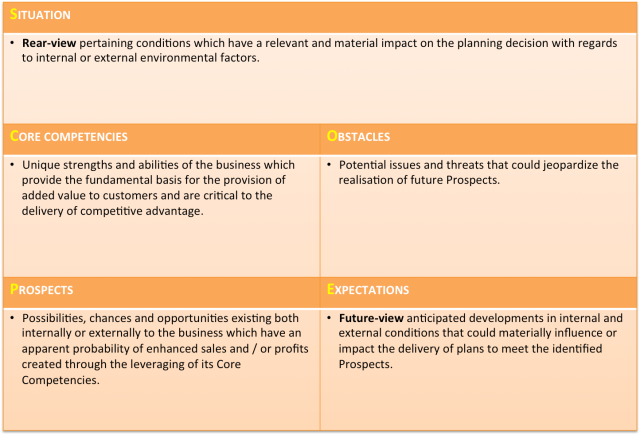The SCOPE Planning Model – An Alternative To SWOT Analysis
 For generations in marketing and business we’ve used the SWOT model to provide an initial analysis and classification of the issues facing a business as it starts to evaluate it’s position and devise strategy. It has served us well since its inception in the 1960s with it’s simplicity, functionality and intuitiveness; remaining un-changed and un-equivocal for over 40 years. It provides a useful tool for segmenting internal and external factors into positives and negatives, yet in doing so it can be limiting in it’s scope to introduce wider factors which could or should come into play when developing our plans.
For generations in marketing and business we’ve used the SWOT model to provide an initial analysis and classification of the issues facing a business as it starts to evaluate it’s position and devise strategy. It has served us well since its inception in the 1960s with it’s simplicity, functionality and intuitiveness; remaining un-changed and un-equivocal for over 40 years. It provides a useful tool for segmenting internal and external factors into positives and negatives, yet in doing so it can be limiting in it’s scope to introduce wider factors which could or should come into play when developing our plans.
Most executives merely use the SWOT as a method of grouping factors into the 4 buckets, with limited conscious effort to align internal Strengths to specific external Opportunities, or to understand Weaknesses in regard to mitigating Threats. In this respect, the SWOT doesn’t provide a progression in it’s strategic development. I’d therefore like to put forward the SCOPE planning model for consideration as an alternative to SWOT:
S – SITUATION: Rear-view pertaining conditions which have a relevant and material impact on the planning decision with regards to internal or external environmental factors.
C – CORE COMPETENCIES: Unique strengths and abilities of the business which provide the fundamental basis for the provision of added value to customers and are critical to the delivery of competitive advantage.
O – OBSTACLES: Potential issues and threats that could jeopardize the realisation of future Prospects.
P – PROSPECTS: Possibilities, chances and opportunities existing both internally or externally to the business which have an apparent probability of enhanced sales and / or profits created through the leveraging of its Core Competencies.
E – EXPECTATIONS: Future-view anticipated developments in internal and external conditions that could materially influence or impact the delivery of plans to meet the identified Prospects.
SCOPE retains many similarities to SWOT, yet allows extra freedom to present additional information and reflections pertinent to the planning process.
The Situation provides an outline and understanding of the prevailing conditions upon which the strategic plan is to be developed. It should consider both internal and external factors which have led the business to its current status, and which have a bearing on the identification of future opportunities, trends and plans.
Core Competencies are specific factors that a business sees as being central to the way it operates which fulfil 3 key criteria:
1. Are not easy for competitors to imitate, i.e. are unique
2. Can be leveraged across products and markets
3. Contribute to the end consumer’s experienced benefits, i.e. add value
In these respects, Core Competencies provide the fundamental basis for the business achieving a competitive advantage in it’s defined market given the pertaining conditions.
Obstacles may be either internal or external, and reflect specific issues which need to be addressed if the business is to realise future Prospects. In this respect, they shouldn’t necessarily be defined as either a “Weakness” or “Threat” but rather be perceived as hurdles to the plan to be overcome over the duration. “Weaknesses” imply longer-term systemic issues causing a strategic disadvantage. Obstacles are shorter-term situations that need to be resolved.
Prospects are chances for the business to create additional sales and / or profits by taking advantage of its Core Competencies in the context of its Situation. Identification of Prospects provides the foundation for both goal setting and strategic development going forward.
Expectations reflect anticipated developments, i.e. what does the planner see happening in the future which could have either a direct or indirect influence on the execution of the plan and achievement of the defined Prospects. What are the key predications that will have a bearing on the plan? These can be both quantifiable and subjective, providing the planner with an appreciation of and insights into the future on which to direct their strategic thinking.
SCOPE is not intended to be a replacement for SWOT. It is not necessarily better. It merely provides an alternative way of categorising the factors upon which strategic development can take place. It enables us to structure our analysis and thinking for framing the context on which to develop strategies and plans in a naturally progressive fashion.
You can now view or download The SCOPE Planning Model PowerPoint presentation at Slideshare here.


one of the better information pieces yet, Thanks!
It expands a bit on the SWOT model but makes you think broadly on each SWOT-like element. I like more the context provided by the ‘Situation’, something which the SWOT model assumed to be in the background.
I guess we also get tired of using the same old thing. It is refreshing to come up with a new-look way of thinking about pretty much the same issues.
Thanks Abner, really appreciate your comment. With SCOPE I wanted to try and take a more rounded, comprehensive view of the factors impacting our planning considerations, as in many respects I find SWOT to have a narrow focus. The term ‘360-view’ is becoming slightly clichéd, but I guess it fits here: backwards / forwards, internal / external, bottom-up / top-down. I hope you find it useful. John
How does the framework capture the weaknesses ?
Thank you
Hi Wail, I consider ‘weaknesses’ in the context of ‘Obstacles’ – in this respect I see them as hurdles to be overcome through the conception and execution of the plan. For me, the term ‘weakness’ has a relatively narrow definition, whereas ‘Obstacles’ cover a broader range of internal and external variables which need to be considered and planned for. I hope this helps. Many thanks, John
Interesting alternative to the traditional SWOT.
It s a useful model, but can you explain by a concrete example or case.
If there are any links or adresses on the internet that i can visit to get more information , please, put me aware of these. Think you
Thanks Imene, I’m afraid that this is something that I’ve only just developed and I don’t have any examples that I’m able to share publically at this point. As soon as I have a case study I’ll definitely put it forward. Thanks again, John
SCOPE model is just an enhancement tool and rewording the elements to make it more intriguing to the professionals.
since SWOT is mostly used in todays strategic analysis, Would this model be a complementary or revised model?
it is good to read about it.
thank you ..
Hi – thanks for the comment. I see this as more of a revised model to SWOT, i.e. you’d use instead of rather than complimentary. Hope this helps, thanks again, John
John:
Looks to me as a fresh new alternative for the old (but very useful) SWOT analysis. I would like to make reference to it (with the proper credit to you) as a new alternate tool. I am a strategy consultant and am constantly looking for new ideas to the accepted ways. Are you OK with this?
Great blog! Thanks for sharing.
Jorge Cruz
TSI STRATEGIC INNOVATION
http://www.tsistrategicinnovation.com
Hi Jorge – many thanks for the comment. Absolutely, please feel free to use and communicate as you wish. Hope it helps. Thanks again, John
I deliver Independent Print Audits to reduce costs across organisations. I use a model developed by Prof. John Thompson (University of Huddersfield) in his Strategic Management Book. This model incorporates SWOT but provides further options to expand on the initial SWOT.
Steve
http://www.printaudit.co.uk
Thanks Steve, I really like Prof. Thompson’s E-V-R Congruence model as Leadership and Culture are hugely important factors in an organisation’s strategic development. Thanks again, John
Fantastic stuff, mate. Finally something truly forward looking. The most important part for strategy development is the “E.” I have grown so weary of the mindless effort spent at “SWOT’ing” programs and processes. SWOT (in my organization) has become a rote method of pigeonholing various factors (that have been reduced to buzz-words) and does not facilitate any real critical thinking. SWOT is easy. SCOPE might actually air the dirty laundry…
Are you anywhere near RAF Mildenhall…? If so, my organization would be very interested in having you come brief this.
Cheers,
Adam
Many thanks Adam, I really appreciate the comment. I had similar frustrations in using SWOT which led me to originally devise the SCOPE framework. It’s definitely intended to be both thought provoking and dynamic (SWOT I find is a somewhat static tool) in that it works on 2 planes: backwards-forwards and laterally, providing a more comprehensive evaluation of the pertaining and potential strategic factors. Let me know how you find it in action and any ideas for how it can be improved. I’m not near Mildenhall I’m afraid, but please let me know if there’s anything I can do to help. Cheers, John
Reblogged this on Mastermind Century Group and commented:
Love this SCOPE concept!